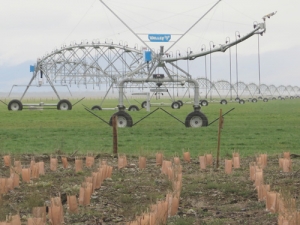Wired for Science: Understanding the feeding habits of mealybug
Fussy children might be frustrating, but fussy mealybugs could help protect the New Zealand wine industry from grapevine leafroll-associated virus 3.
 The Ngai Tāhu Farming project shows there are "means and ways" to restore natural biodiversity into a dairy farming environment.
The Ngai Tāhu Farming project shows there are "means and ways" to restore natural biodiversity into a dairy farming environment.
A new study is showing dairy and conservation sites can co-exist, and its findings are contributing to an ongoing project restoring natural biodiversity into a dairy farming environment.
'Persistence of biodiversity in a dryland remnant within an intensified dairy farm landscape', looks at Bankside Scientific Reserve, a small (2.6 ha) remnant in Canterbury surrounded by dairy paddocks.
It still has valuable communities of native species, despite being impacted by nitrate and phosphate encroachment, and habitat fragmentation.
It concludes "it does not appear to be an intractable management issue for the interface between agricultural systems and conservation sites within a dairy landscape mosaic".
One of the study's authors, Professor of Ecology, Nick Dickinson, and other Lincoln scientists have been tasked by Ngāi Tahu Farming and Manawhenua from Tuahuriri Marae, to turn the little triangles of land which irrigators in paddocks cannot reach into an oasis for native plants and animals on Ngāi Tahu's Eyrewell dairy farm.
Professor Dickinson says the study shows there are "means and ways" to restore natural biodiversity into a dairy farming environment, and the Ngai Tāhu Farming project was an example, covering 150ha on 17 reserves, with a similar additional amount of native species being planted on paddock borders and under irrigators.
These create conditions for more than 65 species of plants to regenerate, and also provide corridors for insects and birds between the reserves.
The research hinges on finding the benefits to the farmer of doing this, to encourage more native planting, he says.
More than 150 people turned up at Parliament recently to celebrate the 20th anniversary of Horticulture New Zealand (HortNZ).
Biosecurity New Zealand says Kiwis should continue to keep an eye out for yellow-legged hornets (Vespa velutina) over the holiday season.
The Push-Up Challenge, an event which combines mental health and fitness, is set to launch in New Zealand in 2026.
Last month's Agritechnica event led to a wide group of manufacturers celebrating successes when the 2026 Tractor of the Year Competition winners, selected by a panel of European journalists, were announced in Hanover Germany.
According to the latest Federated Farmers banking survey, farmers are more satisfied with their bank and less under pressure, however, the sector is well short of confidence levels seen last decade.
Farmer confidence has taken a slight dip according to the final Rabobank rural confidence survey for the year.
President Donald Trump’s decision to impose tariffs on imports into the US is doing good things for global trade, according…
Seen a giant cheese roll rolling along Southland’s roads?